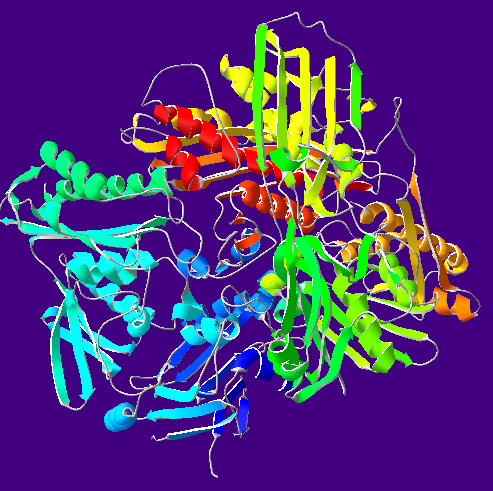Xanthine oxidase
| xanthine oxidase/dehydrogenase | |||||||||
|---|---|---|---|---|---|---|---|---|---|
 Crystallographic structure (monomer) of bovine xanthine oxidase.[1] The bounded FAD (red), FeS-cluster (orange), the molybdopterin cofactor with molybdenum (yellow) and salicylate (blue) are indicated. | |||||||||
| Identifiers | |||||||||
| EC number | 1.17.3.2 | ||||||||
| CAS number | 9002-17-9 | ||||||||
| Databases | |||||||||
| IntEnz | IntEnz view | ||||||||
| BRENDA | BRENDA entry | ||||||||
| ExPASy | NiceZyme view | ||||||||
| KEGG | KEGG entry | ||||||||
| MetaCyc | metabolic pathway | ||||||||
| PRIAM | profile | ||||||||
| PDB structures | RCSB PDB PDBe PDBsum | ||||||||
| Gene Ontology | AmiGO / QuickGO | ||||||||
| |||||||||
| xanthine oxidase/dehydrogenase | |
|---|---|
| Identifiers | |
| Symbol | XDH |
| Entrez | 7498 |
| HUGO | 12805 |
| OMIM | 607633 |
| PDB | 1FIQ |
| RefSeq | NM_000379 |
| UniProt | P47989 |
| Other data | |
| EC number | 1.17.3.2 |
| Locus | Chr. 2 p23.1 |
Xanthine oxidase (XO, sometimes 'XAO') is a form of xanthine oxidoreductase, a type of enzyme that generates reactive oxygen species.[2] These enzymes catalyze the oxidation of hypoxanthine to xanthine and can further catalyze the oxidation of xanthine to uric acid. These enzymes play an important role in the catabolism of purines in some species, including humans.[3]
Xanthine oxidase is defined as an enzyme activity (EC 1.17.3.2).[4] The same protein, which in humans has the HGNC approved gene symbol XDH, can also have xanthine dehydrogenase activity (EC 1.17.1.4).[5] Most of the protein in the liver exists in a form with xanthine dehydrogenase activity, but it can be converted to xanthine oxidase by reversible sulfhydryl oxidation or by irreversible proteolytic modification.[6][7]
Reaction
The following chemical reactions are catalyzed by xanthine oxidase:
- hypoxanthine + H2O + O2 <math>\rightleftharpoons</math> xanthine + H2O2
- xanthine + H2O + O2 <math>\rightleftharpoons</math> uric acid + H2O2
- Xanthine oxidase can also act on certain other purines, pterins, and aldehydes. For example, it efficiently converts 1-methylxanthine (a metabolite of caffeine) to 1-methyluric acid, but has little activity on 3-methylxanthine.[8]
- Under some circumstances it can produce superoxide ion RH + H2O + 2 O2 <math>\rightleftharpoons</math> ROH + 2 O2− + 2 H+.[5]
-
hypoxanthine (one oxygen atom)
-
xanthine (two oxygens)
-
uric acid (three oxygens)
Other reactions
Because XO is a superoxide-producing enzyme, with general low specificity,[9] it can be combined with other compounds and enzymes and create reactive oxidants, as well as oxidize other substrates.
Bovine xanthine oxidase (from milk) was originally thought to have a binding site to reduce cytochrome c with, but it has been found that the mechanism to reduce this protein is through XO's superoxide anion byproduct, with competitive inhibition by carbonic anhydrase.[10]
Another reaction catalyzed by xanthine oxidase is the decomposition of S-Nitrosothiols (RSNO), a reactive nitrogen species, to nitric oxide (NO), which reacts with a superoxide anion to form peroxynitrite under aerobic conditions.[11]
XO has also been found to produce the strong one-electron oxidant carbonate radical anion from oxidation with acetaldehyde in the presence of catalase and bicarbonate. It was suggested that the carbonate radical was likely produced in one of the enzyme's redox centers with a peroxymonocarbonate intermediate.[9]
Here is a diagram highlighting the pathways catalyzed by xanthine oxidase.
A diagram illustrating many of the pathways catalyzed by xanthine oxidase.
Protein structure
The protein is large, having a molecular weight of 270 kDa, and has 2 flavin molecules (bound as FAD), 2 molybdenum atoms, and 8 iron atoms bound per enzymatic unit. The molybdenum atoms are contained as molybdopterin cofactors and are the active sites of the enzyme. The iron atoms are part of [2Fe-2S] ferredoxin iron-sulfur clusters and participate in electron transfer reactions.
Catalytic mechanism
The active site of XO is composed of a molybdopterin unit with the molybdenum atom also coordinated by terminal oxygen (oxo), sulfur atoms and a terminal hydroxide. In the reaction with xanthine to form uric acid, an oxygen atom is transferred from molybdenum to xanthine, whereby several intermediates are assumed to be involved.[3] The reformation of the active molybdenum center occurs by the addition of water. Like other known molybdenum-containing oxidoreductases, the oxygen atom introduced to the substrate by XO originates from water rather than from dioxygen (O2).
Clinical significance
Xanthine oxidase is a superoxide-producing enzyme found normally in serum and the lungs, and its activity is increased during influenza A infection.[12]
During severe liver damage, xanthine oxidase is released into the blood, so a blood assay for XO is a way to determine if liver damage has happened.[13]
Because xanthine oxidase is a metabolic pathway for uric acid formation, the xanthine oxidase inhibitor allopurinol is used in the treatment of gout. Since xanthine oxidase is involved in the metabolism of 6-mercaptopurine, caution should be taken before administering allopurinol and 6-mercaptopurine, or its prodrug azathioprine, in conjunction.
Xanthinuria is a rare genetic disorder where the lack of xanthine oxidase leads to high concentration of xanthine in blood and can cause health problems such as renal failure. There is no specific treatment, sufferers are advised by doctors to avoid foods high in purine and to maintain a high fluid intake. Type I xanthinuria has been traced directly to mutations of the XDH gene which mediates xanthine oxidase activity. Type II xanthinuria may result from a failure of the mechanism which inserts sulfur into the active sites of xanthine oxidase and aldehyde oxidase, a related enzyme with some overlapping activities (such as conversion of allopurinol to oxypurinol).[14]
Inhibition of xanthine oxidase has been proposed as a mechanism for improving cardiovascular health.[15] A study found that patients with chronic obstructive pulmonary disease (COPD) had a decrease in oxidative stress, including glutathione oxidation and lipid peroxidation, when xanthine oxidase was inhibited using allopurinol.[16] Oxidative stress can be caused by hydroxyl free radicals and hydrogen peroxide, both of which are byproducts of XO activity.[17]
Increased concentration of serum uric acid has been under research as an indicator for cardiovascular health factors, and has been used to strongly predict mortality, heart transplant, and more in patients.[15] But it is not clear whether this could be a direct or casual association or link between serum uric acid concentration (and by proxy, xanthine oxidase activity) and cardiovascular health.[18] States of high cell turnover and alcohol ingestion are some of the most prominent cases of high serum uric acid concentrations.[17]
Reactive nitrogen species, such as peroxynitrite that xanthine oxidase can form, have been found to react with DNA, proteins, and cells, causing cellular damage or even toxicity. Reactive nitrogen signaling, coupled with reactive oxygen species, have been found to be a central part of myocardial and vascular function, explaining why xanthine oxidase is being researched for links to cardiovascular health.[19]
Both xanthine oxidase and xanthine oxidoreductase are also present in corneal epithelium and endothelium and may be involved in oxidative eye injury.[20]
Inhibitors
Inhibitors of XO include allopurinol,[21] oxypurinol,[22] and phytic acid.[23] It has also been found to be inhibited by flavonoids,[24] including those found in Bougainvillea spectabilis Willd (Nyctaginaceae) leaves (with an IC50 of 7.23 μM), typically used in folk medicine.[25]
See also
References
- ↑ PDB: 1FIQ; Enroth C, Eger BT, Okamoto K, Nishino T, Nishino T, Pai EF (September 2000). "Crystal structures of bovine milk xanthine dehydrogenase and xanthine oxidase: structure-based mechanism of conversion". Proceedings of the National Academy of Sciences of the United States of America. 97 (20): 10723–8. doi:10.1073/pnas.97.20.10723. PMC 27090. PMID 11005854.
- ↑ Ardan T, Kovaceva J, Cejková J (February 2004). "Comparative histochemical and immunohistochemical study on xanthine oxidoreductase/xanthine oxidase in mammalian corneal epithelium". Acta Histochemica. 106 (1): 69–75. doi:10.1016/j.acthis.2003.08.001. PMID 15032331.
- ↑ 3.0 3.1 Hille R, Hall J, Basu P (April 2014). "The Mononuclear Molybdenum Enzymes". Chemical Reviews. 114 (7): 3963–4038. doi:10.1021/cr400443z. PMC 4080432. PMID 24467397.
- ↑ "KEGG record for EC 1.17.3.2". Genome.jp. Retrieved 23 December 2017.
- ↑ 5.0 5.1 "KEGG record for EC 1.17.1.4". Genome.jp. Retrieved 23 December 2017.
- ↑ "Entrez Gene: XDH xanthine dehydrogenase". Retrieved 23 December 2017.
- ↑ Online Mendelian Inheritance in Man (OMIM) Xanthine dehydrogenase; XDH -607633
- ↑ Birkett DJ, Miners JO, Valente L, Lillywhite KJ, Day RO (February 1997). "1-Methylxanthine derived from caffeine as a pharmacodynamic probe of oxypurinol effect". British Journal of Clinical Pharmacology. 43 (2): 197–200. doi:10.1046/j.1365-2125.1997.53711.x. PMC 2042732. PMID 9131954.
- ↑ 9.0 9.1 Bonini MG, Miyamoto S, Di Mascio P, Augusto O (December 2004). "Production of the carbonate radical anion during xanthine oxidase turnover in the presence of bicarbonate". The Journal of Biological Chemistry. 279 (50): 51836–43. doi:10.1074/jbc.M406929200. PMID 15448145.
- ↑ McCord JM, Fridovich I (November 1968). "The reduction of cytochrome c by milk xanthine oxidase". The Journal of Biological Chemistry. 243 (21): 5753–60. PMID 4972775.
- ↑ Trujillo M, Alvarez MN, Peluffo G, Freeman BA, Radi R (April 1998). "Xanthine oxidase-mediated decomposition of S-nitrosothiols". The Journal of Biological Chemistry. 273 (14): 7828–34. doi:10.1074/jbc.273.14.7828. PMID 9525875.
- ↑ Hemilä H (January 1992). "Vitamin C and the common cold" (PDF). The British Journal of Nutrition. 67 (1): 3–16. PMID 1547201.
- ↑ Battelli MG, Musiani S, Valgimigli M, Gramantieri L, Tomassoni F, Bolondi L, Stirpe F (April 2001). "Serum xanthine oxidase in human liver disease". The American Journal of Gastroenterology. 96 (4): 1194–9. doi:10.1111/j.1572-0241.2001.03700.x. PMID 11316169.
- ↑ Online Mendelian Inheritance in Man (OMIM) Xanthinuria, Type II; XAN2 -603592
- ↑ 15.0 15.1 Dawson J, Walters M (December 2006). "Uric acid and xanthine oxidase: future therapeutic targets in the prevention of cardiovascular disease?". British Journal of Clinical Pharmacology. 62 (6): 633–44. doi:10.1111/j.1365-2125.2006.02785.x. PMC 1885190. PMID 21894646.
- ↑ Heunks LM, Viña J, van Herwaarden CL, Folgering HT, Gimeno A, Dekhuijzen PN (December 1999). "Xanthine oxidase is involved in exercise-induced oxidative stress in chronic obstructive pulmonary disease". The American Journal of Physiology. 277 (6 Pt 2): R1697–704. PMID 10600916.
- ↑ 17.0 17.1 Higgins P, Dawson J, Walters M (2009). "The potential for xanthine oxidase inhibition in the prevention and treatment of cardiovascular and cerebrovascular disease". Cardiovascular Psychiatry and Neurology. 2009: 282059. doi:10.1155/2009/282059. PMC 2790135. PMID 20029618.
- ↑ Dawson J, Quinn T, Walters M (2007). "Uric acid reduction: a new paradigm in the management of cardiovascular risk?". Current Medicinal Chemistry. 14 (17): 1879–86. doi:10.2174/092986707781058797. PMID 17627523.
- ↑ Zimmet JM, Hare JM (October 2006). "Nitroso-redox interactions in the cardiovascular system". Circulation. 114 (14): 1531–44. doi:10.1161/CIRCULATIONAHA.105.605519. PMID 17015805.
- ↑ Cejková J, Ardan T, Filipec M, Midelfart A (2002). "Xanthine oxidoreductase and xanthine oxidase in human cornea". Histology and Histopathology. 17 (3): 755–60. PMID 12168784.
- ↑ Pacher P, Nivorozhkin A, Szabó C (March 2006). "Therapeutic effects of xanthine oxidase inhibitors: renaissance half a century after the discovery of allopurinol". Pharmacological Reviews. 58 (1): 87–114. doi:10.1124/pr.58.1.6. PMC 2233605. PMID 16507884.
- ↑ Spector T (Jan 1988). "Oxypurinol as an inhibitor of xanthine oxidase-catalyzed production of superoxide radical". Biochemical Pharmacology. 37 (2): 349–52. doi:10.1016/0006-2952(88)90739-3. PMID 2829916.
- ↑ Muraoka S, Miura T (February 2004). "Inhibition of xanthine oxidase by phytic acid and its antioxidative action". Life Sciences. 74 (13): 1691–700. doi:10.1016/j.lfs.2003.09.040. PMID 14738912.
- ↑ Cos P, Ying L, Calomme M, Hu JP, Cimanga K, Van Poel B, Pieters L, Vlietinck AJ, Vanden Berghe D (Jan 1998). "Structure-activity relationship and classification of flavonoids as inhibitors of xanthine oxidase and superoxide scavengers". Journal of Natural Products. 61 (1): 71–6. doi:10.1021/np970237h. PMID 9461655.
- ↑ Chang WS, Lee YJ, Lu FJ, Chiang HC (Nov–Dec 1993). "Inhibitory effects of flavonoids on xanthine oxidase". Anticancer Research. 13 (6A): 2165–70. PMID 8297130.
External links
- Xanthine+Oxidase at the US National Library of Medicine Medical Subject Headings (MeSH)


